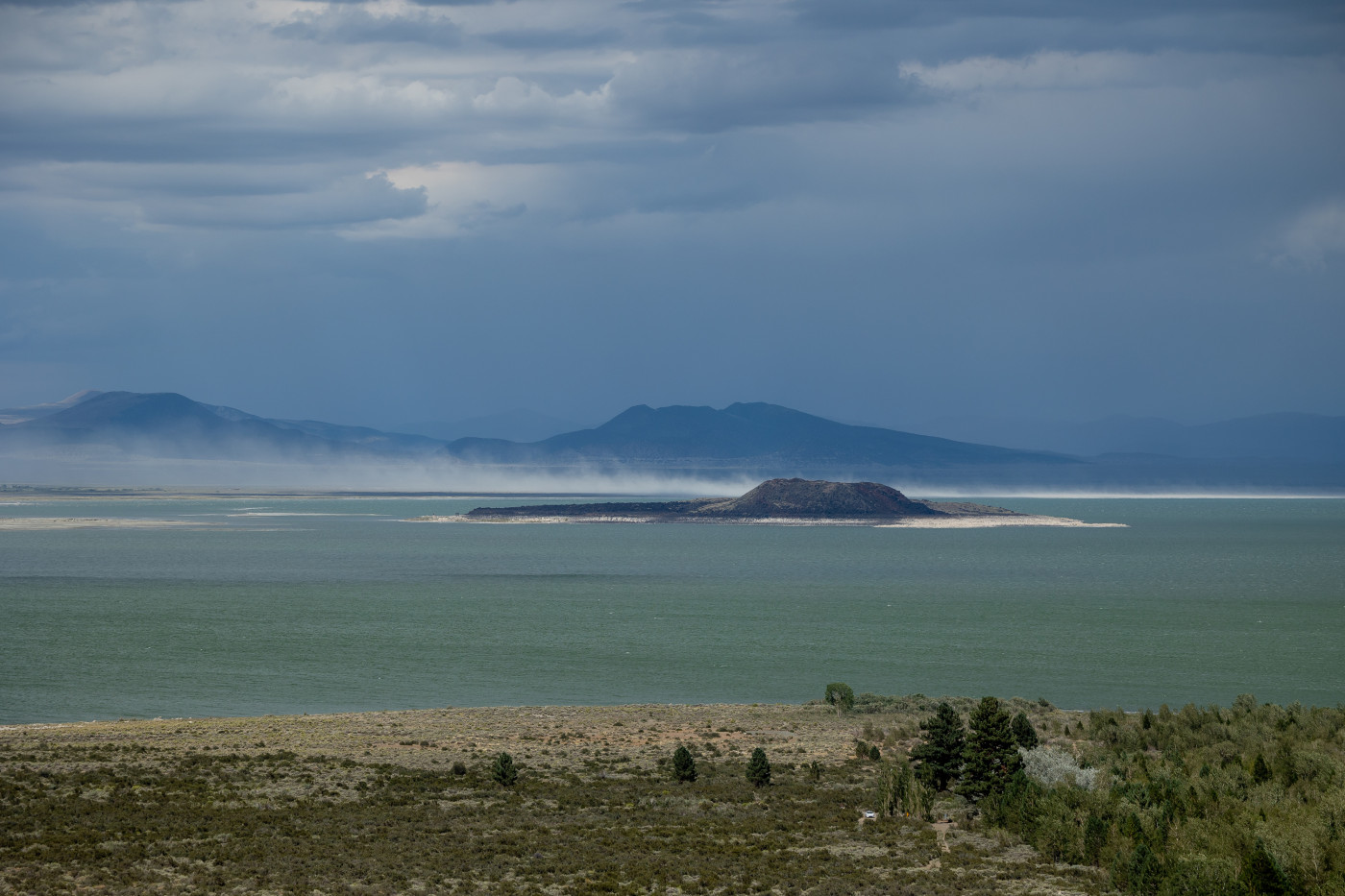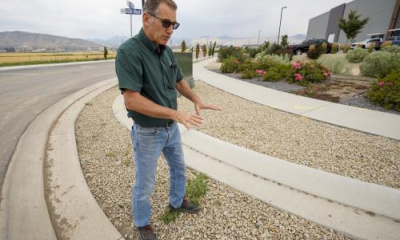In September 1981, a group of 11 cyclists collected vials of water from a Los Angeles utility’s decorative reflecting pool and biked 350 miles north to Mono Lake’s shore.
“They returned the water to its natural destination,” a Mono Lake Committee newsletter proclaimed. There was a growing awareness that the situation at Mono Lake had become dire.
Thousands of baby gulls were dead, stacked high in piles. The nutrient-rich brine flies were missing. Earlier that year, brine shrimp counts were down by as much as 95%, the lake choked with algae they would have normally grazed.
The Los Angeles Department of Water and Power, meanwhile, diverted away as much water as it pleased from Mono Lake’s tributary streams.
It was a similar circumstance that the Great Salt Lake faces today. But just as Utahns have begun rallying to save their shrinking lake from disastrous consequences, Californians put on the pressure in the 1980s to save Mono Lake from shriveling away.
The Mono Lake Committee urged people across the state to contact their congressional representatives, to write letters of protest to LADWP, to donate money to the group’s expensive and ongoing legal fight against the utility, which bizarrely continued to insist its diversions weren’t the source of Mono Lake’s problems.
By the winter of 1983, the courts had made a decision. The lake must be managed for the benefit of the public — it couldn’t be siphoned to dust by L.A., which held most of the Mono Lake basin’s water rights.
But it wasn’t a complete victory for Mono Lake advocates. Judges ruled both the lake and L.A. held legitimate claims to the water.
Those two interests needed to find a balance.
“What is the lake level we need for a healthy ecosystem? How much water needs to be delivered … to L.A.?” said Robbie Di Paolo, Mono Lake Committee’s current restoration field technician. “It was an extensive modeling effort.”
It took years of study, a 1,700-page environmental impact report, dozens of other scientific studies and more than 40 days of fielding public comment. But in September 1994, the state of California found its number.
It determined Mono Lake must rise to 6,392 feet above sea level — 20 feet higher than its record low.
The benefits of having a number
All these years later, the lake still hasn’t hit that mark. But L.A. has adopted significant cutbacks and conservation measures, helping to reverse Mono Lake’s rapid rate of decline.
“The question is, we've waited. We've given L.A. the opportunity to adapt to decreased water,” Di Paolo said. “What do we need to do to now benefit Mono Lake, which has not seen the improvement it was mandated to have?”
It’s a conundrum that will undoubtedly be hashed out in the future as climate change and the current “megadrought” have defied everyone’s expectations. But what Mono Lake has working in its favor is a number. A target elevation. A requirement that it must rise until it reaches a specific, measurable level. Until then, the growing population of L.A. will have to figure out ways to live with less.
So, is it time for Utahns to set a decree for the Great Salt Lake, before it, too, becomes a wasteland of dead birds and disappearing brine shrimp?
At least some lake advocates say yes.
“We need to look at a target elevation for the system, just like Mono did,” said Lynn de Freitas, executive director of FRIENDS of Great Salt Lake. “And we need to use that as a goal so we know how we're doing.”
Scientists and environmental groups have worked hard to educate the public and policymakers about a need to send more water to the Great Salt Lake. Otherwise the millions of people living nearby face a future with more toxic dust pollution, dead birds, and, potentially, endangered species listings.
And, in recent years, lawmakers have scrambled to revise Utah’s century-old water laws to increase flexibility. Just this year, they invested $40 million into restoring the lake.
But how do we know when we’ve done enough?
“We don't know where we're trying to go,” de Freitas said. “We just know that we're trying to bring water to the system and help people understand why.”
Luckily, the state’s scientists and decision-makers don’t have to spend years modeling and forecasting and researching what level of water the Great Salt Lake needs. The Department of Natural Resources did all that work about a decade ago, when it developed its Great Salt Lake Elevation Matrix in 2013.

The Great Salt Lake ‘Goldilocks zone’
Terminal waters like the Great Salt Lake and Mono Lake fluctuate by nature, responding to the climate. Those living near these lakes have seen the detrimental effects of low water firsthand. But too much water can give rise to problems as well.
Longtime Utahns might remember 1983, when the Great Salt Lake swelled by 5 feet and hit a record high elevation. The streets of Salt Lake City became rivers. The Bear River Migratory Bird Refuge sustained major damage. With that influx of fresh water, ecologists worried about how dropping salinity levels might impact the brine shrimp, birds and bugs the lake supports. The state spent millions on pumps that spewed all the lake’s excess water into the West Desert.
The matrix takes all these elevation ranges into consideration, identifying a range where the industries, cities and environment around the Great Salt Lake are sustained.
“The long-term historically healthy elevation is 4,200 feet,” said Joel Ferry, the department’s new executive director. “That’s the sweet spot. Not too hot, not too cold. It’s the Goldilocks zone.”
The lake will need to rise by about 11 feet to reach that magic number, a staggering amount considering the lake’s size.
But Ferry’s optimistic.
“In 2017, the lake went up 6 feet,” he said. “It’s totally possible. … The efforts we’re doing are going to make [big] differences.”
Ferry has experience and perspective when it comes to the Great Salt Lake. His family has farmed for generations near its shores and that of its largest tributary, the Bear River. Before taking the job at the Department of Natural Resources, Ferry also worked as a legislator. He helped draft some of the recent bills shaking up water policy and improving the lake’s health.
A law-binding elevation similar to Mono Lake, however, won’t work in his view. Utah doesn’t have much political appetite for mandates.
“What you’re talking about is a rigid approach, all or nothing,” Ferry said. “We need to be flexible and mindful and adaptive to a condition we find ourselves in.”
He praised Utahns for their conservation efforts so far — Weber Basin cut its water use by 22% compared to last year, and Salt Lake City saved an astounding 2.9 billion gallons.
Ferry said he has a list of 120 additional solutions for the Great Salt Lake that run the gamut of possibilities, from a pipeline to the Pacific Ocean to helping farmers pay for efficient irrigation.
“When I came into this office,” Ferry said. “I saw we weren't doing much on cloud seeding. I said we need to do more.”
Back in 1981, when Mono Lake was collapsing, L.A. Water and Power proposed the same thing, much to lake advocates’ exasperation.
“Cloud seeding, like any technological fix, may have deleterious long-term ecological consequences,” the Mono Lake Committee warned in its newsletter. “It would be safer to mend our water-wasteful ways.”
One perturbed L.A. resident wrote the utility about “balance” and living within nature’s whims. “There’s ‘enough for everyone’s need,’” she said, quoting Mahatma Gandhi, “‘but not for everyone’s greed.’”
What's your response to At Water's Edge?
Does this reporting project make you feel hopeful? Concerned? Inspired? Surprised?
Selected responses will be used on social media, on our website or in our newsletter.









